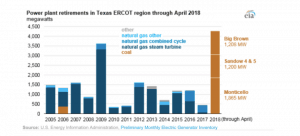Factors Driving Increased Summer Electricity Prices in Texas
Electricity demand and prices tend to skyrocket in the summer. Here’s why.
You may have noticed a dramatic difference between your energy bills in April and July – especially if you live in Texas.
You’re far from alone – in Texas, electricity prices typically spike in the summer. During the warmer months, demand increases, and more pricey power sources get added to the mix.
As the Houston Chronicle reports, “Forecasts of higher than normal temperatures and record power demand are coinciding with the shutdown of at least three coal-fired plants, leading to concerns that temporary shortages on the hottest summer days could send wholesale prices, which typically average less than $50 per megawatt hour, spiking to $3,000 per megawatt hour or higher.”
Let’s explore each of those factors in more depth.
Higher Temperatures
A slight increase in temperature during recent summers has caused a spike in air conditioning use, according to the Energy Information Administration (EIA).
2019 may bring the hottest temperatures to date. Why? The culprits are climate change and El Niño. The four hottest years on record have occurred from 2015 to 2018, signifying a growing trend.
Peak Demand
When does peak demand occur? During hot summer afternoons when Texans across the state are blasting their air conditioners.
Industry needs are also causing demand to spike. Natural gas and oil developers are consuming increasing amounts of electricity, even as many generation facilities are shutting down, causing wholesale energy prices as well as retail prices to spike.
More Expensive Electricity Generation Sources
An increase in the prices of natural gas – a primary source of electricity – has also led to a spike in electricity prices for consumers.
With the recent retirement of many coal-fired plants, Texas is transitioning away from some traditional energy sources at a time when demand is skyrocketing. This means the state has fewer facilities with which to meet the rising demand, although wind power is becoming increasingly competitive.

In fact, coal-fired power plants are shutting down largely because it’s becoming difficult for them to compete with wind power – which bodes well for the future of Texas electricity.
Investment in energy infrastructure has caused a surge in prices as well. Like the transition away from coal and toward renewables, this factor may be causing a temporary surge in prices rather than a permanent one.
Given all of these factors, the Electric Reliability Council of Texas (ERCOT), which manages the state’s electricity grid, expects to see record demand this summer. The state will generate about 78,154 megawatts of electricity this season, while demand will reach roughly 74,853 megawatts.
Will consumers face a loss of power at times of peak demand this year? It’s unlikely.
During times of peak demand, the ERCOT can declare an alert and leverage several contingency measures. Those options include:
- Importing energy from neighboring states;
- Additional ways of producing power;
- Demand response initiatives;
- Requests that consumers conserve energy voluntarily.
Rolling blackouts can also be employed, although they haven’t occurred since 2011. When these happen, they’re carefully orchestrated and typically don’t last long.
Locking in your electricity rate with a contract that maintains a fixed cost can prevent your bills from skyrocketing at times of peak demand. If you’re concerned about your summer energy costs, this will give you much peace of mind!
Updated on



